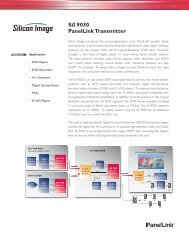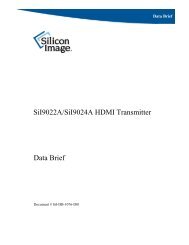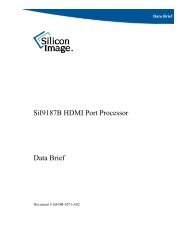Create successful ePaper yourself
Turn your PDF publications into a flip-book with our unique Google optimized e-Paper software.
ADVANCE INFORMATION<br />
<strong>UAC</strong> <strong>357xB</strong><br />
3.8.1. Dynamic Amplification<br />
Since the human impression of loudness depends on<br />
the frequency, a dynamic <strong>com</strong>pression of the low frequencies<br />
adapts the sound to the human perception.<br />
In order to prevent clipping and to adapt the system to<br />
the signal amplitude which is really present at the output<br />
of the device, the MB contains a definable limit.<br />
The output signal amplitude is monitored and if it<br />
<strong>com</strong>es close to the limit, the gain is reduced automatically.<br />
Clipping effects are avoided.<br />
Amplitude<br />
(db)<br />
MDB_LIMIT<br />
Signal Level<br />
MDB_CF<br />
SUBW_FREQ<br />
Frequency<br />
Fig. 3–3: Dynamic amplification<br />
3.8.2. Adding Harmonics<br />
MB exploits the psychoacoustic phenomenon of the<br />
‘missing fundamental’. Adding harmonics of the frequency<br />
<strong>com</strong>ponents below the cutoff frequency gives<br />
the impression of actually hearing the low frequency<br />
fundamental. In other words: Although the loudspeaker<br />
system is not capable of generating such low<br />
frequencies, the listener has the impression that it<br />
reproduces them.<br />
Amplitude (db)<br />
MDB_CF<br />
Frequency<br />
Fig. 3–4: Adding harmonics<br />
Micronas Aug. 20, 2004; 6251-650-1AI 21







